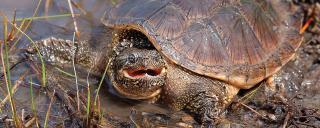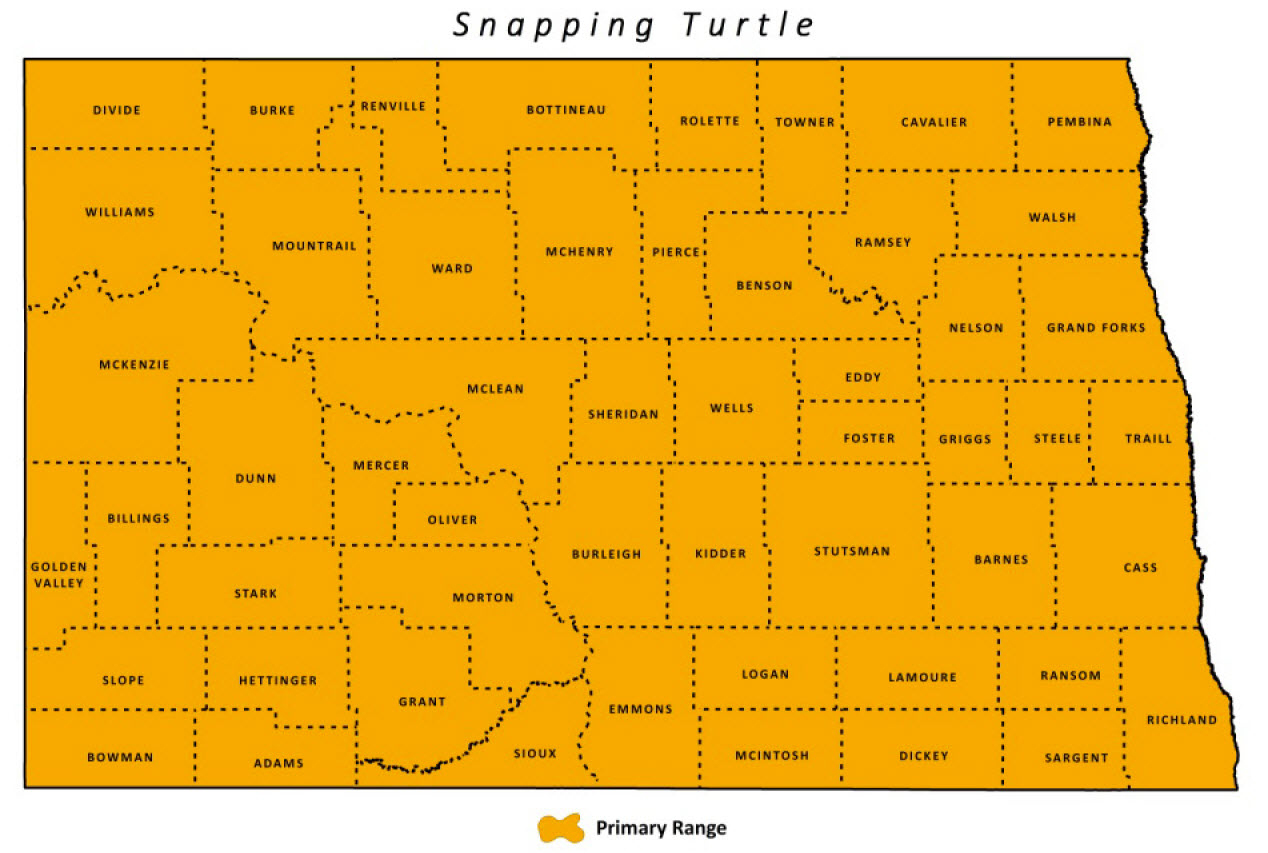
Snapping Turtle
| Scientific Name | Chelydra serpentina |
|---|---|
| General Description | L 8-30”, 65lbs. Brown to gray turtle with undersides of light tan or gray. Snapping Turtles have a large head, hooked jaw, muscular limbs, webbed feet with long claws and a long, robust tail. Carapace often covered with green algae. |
| Status | Year-round resident. |
| Abundance | Fairly Common. |
| Primary Habitat | Warm water in permanent lakes or rivers with a muddy bottom and plenty of aquatic vegetation. |
| Federal Status | No federal status. |
| Reason for Designation | Listed as vulnerable in Montana, Minnesota, Saskatchewan and Manitoba by NatureServe. Although found statewide a recent study indicates that they may not be as abundant as originally thought. |
Locations and Conditions of Key Habitat
Preferred Habitat
Snapping Turtles can be found in slow-moving rivers and streams carrying a high sediment load, or large permanent or semi-permanent bodies of water with a muddy bottom and warm water. Often reside in the margins of ponds, buried in the mud with only eyes exposed. Feed on invertebrates, carrion, aquatic plants, fish, amphibians, other turtles, small mammals, or baby birds.
Key Areas and Conditions for Snapping Turtle in North Dakota
Snapping Turtles are found statewide. Recent work indicates that they prefer water bodies that are flowing or have access to flowing water.
Problems Which May Affect this Species
Habitat
The loss or lack of aquatic vegetation, stumps, logs, and other debris could affect this species.
Other Natural or Manmade Factors
Road mortality may contribute to the decline. Harvest of Snapping Turtles for their meat is largely unregulated and may be a factor in some areas. Contaminants have been linked to population decline or abnormal development in some areas. Snapping Turtles are sometimes deliberately killed because of perceived danger.
Research and Survey Efforts
Current Research or Surveys
- North Dakota State University is surveying reptiles and amphibians in SE North Dakota.
Previous Research or Surveys
- The University of Idaho did a population and status assessment of Snapping Turtles in North Dakota. 2012.
- The North Dakota Game and Fish Department sampled turtles in the Missouri River. 2005-2007.
- Wheeler and Wheeler (1966) conducted a statewide survey of all amphibians and reptiles, as well as compiled existing records. The turtles were found statewide in permanent water.
- The REAP program (1978) rarely observed Snapping Turtles, but indicated they are abundant in permanent bodies of water.
- Hoberg and Gause (1992) recorded personal observations of Snapping Turtles in North Dakota.
- A compilation of all records in North Dakota by Jundt (2000) listed around 35 documentations of the Snapping Turtle in the state.
Additional Research or Surveys Needed
- Identify important nesting and over-wintering habitat
- Develop a management plan for Snapping Turtles
- Monitor more closely the harvest of Snapping Turtles
Management Recommendations
- Develop a management plan for Snapping Turtles
- Identify and Protect nesting and over-wintering sites
- Develop harvest guidelines where populations are sustainable.
- Avoid clearing or replacing natural vegetation along wetland edges, providing at least 50-75 feet of undisturbed habitat to protect water quality and prevent erosion.
- Maintain the natural water level and fluctuations of wetlands.
- Leave logs, snags, and other woody debris on site and replace if removed.
- Erosion control structures such as retaining walls or rip-rap will limit or prevent access to the shoreline and adjacent habitat.
- Do not alter natural river undulations, backwater areas, or sand and gravel bars.
- When possible, keep cattle out of streams to reduce impacts on water quality and the streambed.
- Develop information to educate the public on the importance of Snapping Turtles
Monitoring Plans
There currently is no monitoring protocol in place.
2005-2015 Progress
The Snapping Turtle maintains its Level iI Species of Conservation Priority ranking. The University of Idaho conducted statewide surveys as well as collected important life history information. (T-29-R Population and Status Assessment Strategies Applied to a Management Plan for the Snapping Turtle Chelydra serpentina in North Dakota). A number of management recommendations from this study will direct future work on this species.

Note: A listing of works consulted when compiling the information on this page may be found in the 2015 State Wildlife Action Plan.
